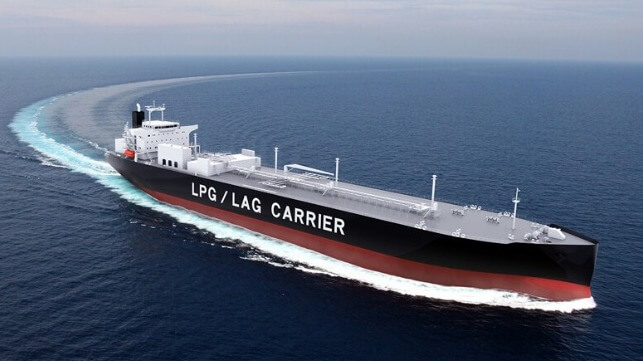Shipbuilders Make Progress with Designs for Ammonia-Fueled Ships

The shipbuilding sector continues to report strong progress in developing future designs to use ammonia as the primary fuel. Designers are working to develop ships in each of the primary categories that in the future will be able to use the new fuels and provide shipowners a viable migration path to future-proof current investments in ships. Japan’s Mitsubishi Shipbuilding and South Korea’s Samsung Heavy Industries each reported design approval for additional ships designed to employ ammonia as their primary fuel.
While ammonia is expected to come into wide use in the future as a stable and clean source of energy, shipbuilders and shipowners face challenges to incorporate the future fuel into their current designs. Announcing its MOU with Hyundai Heavy Industry for a future order for an ammonia-fueled gas carrier, Singapore-based Eastern Pacific Shipping pointed out this week that there is no engine commercially available in the market today that can use ammonia as a marine fuel. Further, EPS expressed its belief that ammonia-ready vessels currently on order will be able to switch from other alternative marine fuels but will still require a major engine retrofit once ammonia engines become commercially accessible.
Mitsubishi Shipbuilding in announcing that it has completed a conceptual design of a Very Large Gas Carrier (VLGC) said its approach was to initially power the vessel with liquefied petroleum gas (LPG). They believe that LPG would provide an easier migration path to ammonia when the technology is available and by the creation of a design enabling conversion to ammonia fuel they expect it will permit relatively small-scale ship retrofitting when the use of ammonia fuel becomes a viable option.
The conceptual design of an LPG-powered VLGC enabling future conversion to ammonia fuel was developed based on Mitsubishi Shipbuilding’s experience in the construction of more than 80 very large LPG carriers and multi-purpose gas carriers capable of carrying ammonia. The VLGCs, in addition to using LPG fuel as an alternative to the conventional heavy oil, can also transport ammonia as cargo. As such, Mitsubishi says VLGCs are highly suited to using ammonia fuel in the future. In recent years Mitsubishi Shipbuilding has been conducting investigations into the potential use of ammonia fuel in VLGCs and they reported the design has received an Approval in Principle (AiP) from the Japanese classification society ClassNK.
Samsung Heavy Industries also reported completing designs for an ammonia-fueled Neo-Panamax container vessel. The vessel is the next step in the South Korean shipbuilders growing list of ammonia-fueled designs. ABS reported that it reviewed the design against its standards and also granted an Approval in Principle (AiP) for the design.
The South Korean shipyard previously detailed its efforts to develop ammonia-ready ships and develop an ammonia-fueled tanker. Samsung is working with MISC Berhad, Lloyd’s Register, MAN Energy Solutions, YARA, and MPA Singapore to develop an ammonia-fueled tanker. In 2020, Samsung was also granted Approval in Principle (AiP) by Lloyd’s Register for an ammonia-fueled tanker design. Samsung Heavy reported that it aims to commercialize by 2024 designs for its Aframax crude oil tanker fueled by ammonia.
